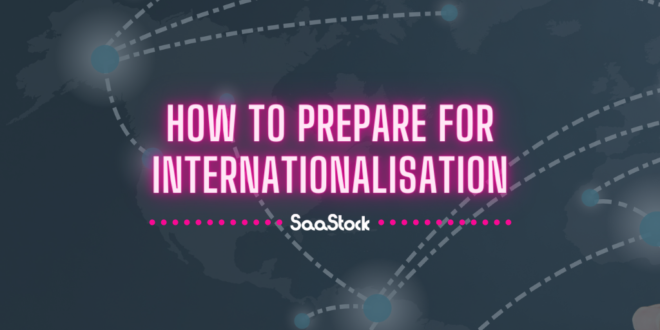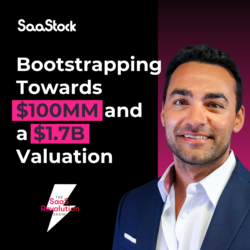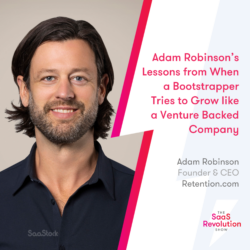If you are not subscribed, join the community by subscribing here and share it with your fellow SaaS enthusiasts.
“Thinking through what kind of company you are and your motivations for why you’re expanding will give you a lot of good pointers as to when you should be making the leap“, said Ari Helgason, former Principal at Index Ventures, on SaaStock’s How-To series.
Tapping into a new market takes months of preparation. From understanding the market and doing in-depth customer research, to figuring out the maturity of your customers and competition, each element plays a vital role in making your move a success.
So, how can you prepare for internationalisation?
Before taking the big step, you need to figure out three things:
- What kind of company are you?
- Have you prepared the ground?
- Are you committed to execute against your plan?
Watch now:
Index Ventures published a report on internationalisation, Destination USA, last year. The study encompasses 275 European and Israeli startups that have expanded to the US in the last eight years, including 33 unicorns such as Spotify, UiPath, Adyen, and more.
Find out more insights from the report and top tips on how to prepare for internationalisation, from Ari. Watch the full video on our YouTube channel. You can also read the full transcript of this video below.👇
Transcript
Alex Theuma
Welcome to the SaaStock How To series, in which we aim to answer the questions posed by our community and give you three actionable takeaways. I’m Alex Theuma, CEO of SaaStock, which helps companies get traction, grow, and scale. And today I’m joined by Ari Helgason, investor at Index Ventures. Welcome, Ari.
Ari Helgason
Thank you. Great to be here.
Alex Theuma
Good to have you here. Well, we’re chatting just ahead of SaaStock EMEA, which is taking place on the 12th to the 15th of October. And we know that Index Ventures have just published a mammoth report on internationalization, Destination USA. So I thought when this question was posed by our community, how to prepare for internationalization, that this was perfect timing to ask you to come on and answer that question. So Ari, how do you prepare for internationalization?
Ari Helgason
Yeah, so before I jump in, we’ve been doing this for 25 years, supporting tech companies and internationalizing to the US from Europe. And the study we did encompasses 275 European and Israeli startups that have expanded to the US in the last eight years, including 33 unicorns. So we did a lot of in-depth interviews with founders of those unicorns, including Spotify, UiPath, Adyen, and lots of others. So there’s lots of stuff in the book on how to do it and it’s available on our website, indexventures.com.
But in terms of the three major things that you need to do, I would focus on first of all figuring out what kind of company are you. And we have an app online where you can figure out what type of archetype you are, figure out what that means for how you should be thinking about expansion, with lots of case studies from each archetype. The second thing is, prepare the ground. So I’m going to talk about some specific things you can do to get things going. And then the final thing is jumping in and execute it. So I’m going to talk about each of those three, if that sounds good.
Alex Theuma
Sounds good. Sounds good. Let’s do it.
Ari Helgason
Cool. So the first thing you need to do is figuring out what kind of company you are. And the top reason we found when speaking to entrepreneurs for why they expand to the US, it’s really about access to customers. So US software spend by enterprises is more than double that of Europe, and it’s also growing faster than Europe. So if you want to build a iconic global SaaS company, you really need to be thinking about where’s your major market and you need to be thinking about the maturity of the customers and the competition. And so it’s really a kind of personality test type tool that you can use to run through scenarios and look at what your expansion path into the US might look like.
For SaaS companies there are two major archetypes that we talk about. So one is, we call it the compass, which is really the one where you build it in Europe but sell in the US. And so common examples of that might be Colibra, Mimecast, Algolia, UiPath. So often the bigger ticket, enterprise sales focused companies. And then the second archetype is the telescope, which is much more common for bottom-up, high velocity SaaS companies like Typeform or PipeDrive or Intercom to some extent. And those companies tend to focus on the US market while maintaining some center of gravity in Europe still. And thinking through what kind of company you are and your motivations for why you’re expanding to the US will give a lot of good pointers to when should you be making the leap and to think about what your journey might look like. And there are lots of founder interviews and case studies in the book that will help you assess where you fit in and what might be the right time.
The second thing to do is to start preparing the ground. And this is really where you start the real work. And specifically that often means setting up a task force. So you can either appoint someone on your team or a freelancer to do this sort of work. It’s a sort of consulting, like strategy consulting like exercise. You preferably want someone who’s quite analytical with some go-to market experience, and importantly an understanding of the US context. So it might be someone that lives in the US or an ex-pat from the US or a European who’s lived there. So you want someone who can hit the ground running and get a feel for what the market is like.
You then typically want to give yourself a three-month research timetable to dig into key questions that will allow you to get to a go, no go decision. And the core questions that you’re digging into in this stage is really understanding the market, doing in-depth customer research. In some ways you’re really finding product market fit all over again. It’s surprisingly rare that you can take a SaaS product and just plunk it down in the US if you’ve been selling in Europe without any product tweaks. There are definitely going to be some tweaks that you need to make. And so it’s important that you start to have customer conversations and someone that’s responsible for figuring out what those product tweaks are likely to be.
Third, you want to do competitive research, positioning. You ultimately want to be in a position where you can pitch against all your competitors in the US and win, so you really want to understand their strengths and weaknesses and position accordingly. You want to do product localization. Fifth, you want to do location recommendations. So you want to look at, do you want to be East Coast, West Coast, somewhere in between? There are lots of pros and cons to pretty much every city you could think of setting up in. And so you want to do a structured analysis of the different options and figure out which one works for you.
Then you have the regulatory context, especially if you’re selling into financial services or you’re in healthcare or other regulated industries. You want to make sure that you’re doing your homework on regulatory stuff well in advance, because licensing can take quite a long time. Then you have operational considerations, all the legal, financial, HR, IP, subsidiary structuring, et cetera. Get your lawyers involved there and figure out what that might look like. You want a pre and post launch timetable that you need to come up with. And then finally, a year one budget and hiring plan. And on the budget, the really important thing to remember is that you want to have different contingencies. And you want to be planning for success, ideally. So you want to be thinking about, what are the things I’m looking for that will tell me when it’s time to double down? And in the early days it might be, okay, we’ve identified product market fit. We have all our ducks in a row when it comes to regulatory stuff, and we’re ready to just go for it and execute.
And that could be a good trigger for putting more budget, hiring more people, et cetera. So you have an initial budget and then you have to be quite structured about thinking about what are the lessons learned or hypotheses that you need to prove in order to double down on expansion. So that’s the second point, preparing the ground. The final piece is really on the execution. So once you’ve got your plan in place, you know that you want to expand, you know what that’s going to look like, you have a budget against it, you really want to jump in both feet and really commit to the US expansion. And this is another common pitfall I’ve seen quite a lot of, which is that companies might put a few people, put a landing team together in the US, and then fail to really double down or really commit to it.
And that can lead to cultural problems where the US expansion team doesn’t feel adequately supported, and it can mean that the opportunity might be there, but you’re not resourcing sufficiently to really make that team successful. And so the commitment is really important, which is why you want to make sure that you’ve paired it with having enough money in the bank to really invest properly in the expansion. So execution means getting the landing team in place. Ideally every person on the landing team needs to have an essential set of skills that are relevant in the early days, typically more go to market oriented, and they also should be carriers of the company culture. So you want to bring people preferably who’ve been at headquarters in Europe and really understand what the company’s about, have a deep understanding of both the product and the culture and how you work, who will form that initial launch party.
And typically this will consist of two to four individuals in the beginning. Some will be quite senior, one or two of them will be more junior. And you’re mostly looking at the commercial skill set, so sales, marketing. You may want to add a product person or at least a developer or two if there’s a lot of localization and product work that’s required, and then get the visa process going and prepare for the move. The big question that comes up at this point is always, should a founder move, yes or no? I tend to lean towards yes. It somewhat goes back to the archetypes. So for the compass archetype where most of the market is in the US and you’re really looking to build the commercial side of the business in the US, you pretty much have to have a founder move.
So it’s important that a founder goes with that initial landing team, but in other cases it’s not a necessity. The main thing to consider is that it’s important that things are stable and humming along nicely in the headquarters before a senior person moves across to the US, just to ensure that there’s still someone who can steady the ship and run things day to day at headquarters while one founder or one senior individual from the management team figures out the US expansion. So those would be the three points that I would highlight, but there’s obviously a lot of nuance and a lot more to be said about any one of them.
Alex Theuma
Awesome. Well, Ari, thanks so much for distilling it down into three points. And I look forward to reading Destination USA, which of course I think we’ll cover that a lot more in depth, and find that at indexventures.com. So Ari Helgason, thank you so much for joining us today on the How To series and sharing the answer on how to prepare for internationalization.
Ari Helgason
Thanks a lot, Alex. Thank you.







